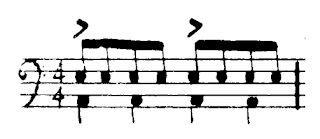A baseline thing to do with Reed funk methods is to practice in two measure phrases. For example: one measure cut time funk* / one measure RH lead**.
* - CUT TIME FUNK: Reading from Syncopation, play melody rhythm on bass drum, except play the 3 on the snare drum— adding it to the written rhythm if necessary—add quarters/8ths on cymbal.
** - RH LEAD: Play melody rhythm on cymbal with RH, plus bass drum in unison. Fill in gaps in rhythm with LH on SD to make a full measure of 8th notes.
Here's how you would play that phrase reading line 1 on p. 34 of Syncopation— look it up, the rhythm is
1& &3 4:
As you get deeper into practicing that, especially when running the full-page exercises, that formula creates some rather artificial connections between the two measures— the resulting thing is not how I would play. Or maybe there are some hipper possibilities, that move more naturally. We'll look at some examples of that from Exercise 1 on p. 38 of Syncopation.
You could play the page straight through, or isolate any two measures and repeat them. Let's isolate measures 2-3 of line 2:
Played strictly first measure: cut time funk / second measure: RH lead:
It's kind of weird to just start a measure with a ghost note. You could accent that note instead, or just start the RH lead portion earlier, on beat 4:
With measures 3-4, also on line 2:
Played like this with the straight formula:
On the repeat, we're hitting the cym/bd on the
& of 4, and cym only on 1. I'm more inclined to put an accent on that
& of 4— let's do it on an open hihat, closing it on 1.
I'll also start the RH lead part early, as on the last example:
The first two measures of line 3:
By the formula:
Like with the first example, I would start the LH filler early. And if I wanted to play a crash on 1 at the beginning of the phrase, I would not hit the cymbal along with the bass drum on the & of 4 at the end. The 4 at the end of the phrase would be a natural place to accent the snare drum, as well:
Some ideas to think about. This covers most situations you'll encounter practicing from Syncopation. Maybe there will be spots where you'll want to figure your own thing out. Always feel free to make your own alterations. These types of practice systems are neither perfect nor sacrosanct. In a sense the point of practicing is to learn new stuff, but it's also to learn it in a way that connects to what you already know how to do.











































